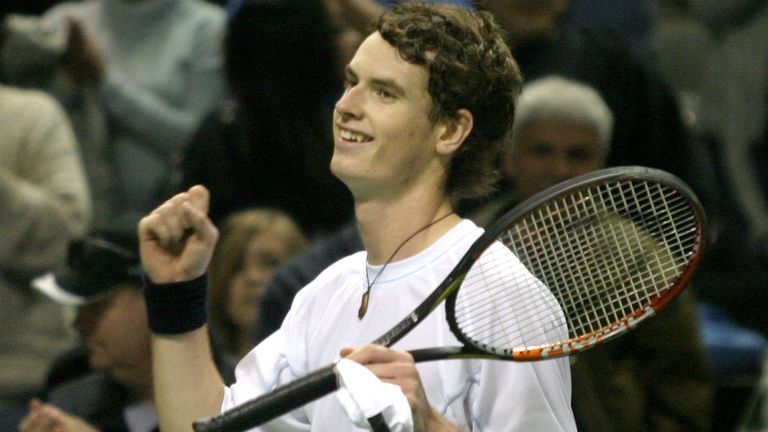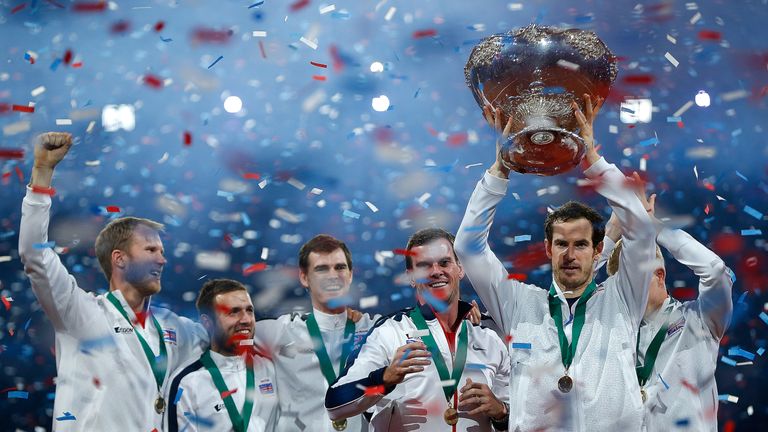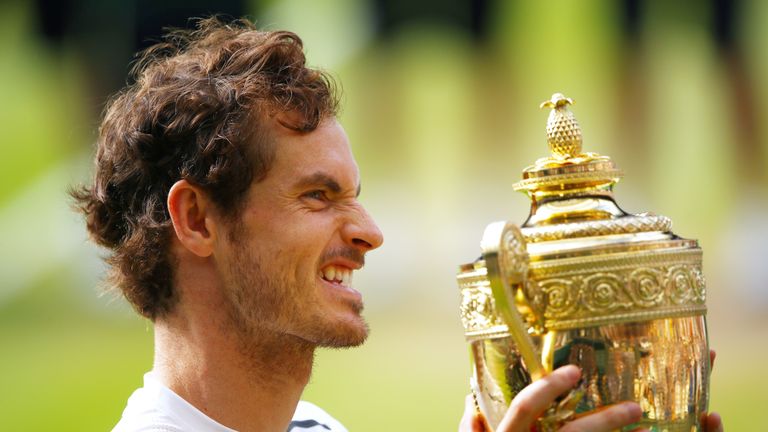Andy Murray had to beat the very best in men's tennis to become one of the greats

Tuesday 29 January 2019 13:10, UK
Andy Murray has done it all. Here, we look back at the most significant moments in his career.
The two-time Wimbledon champion was debating having the hip surgery procedure, which involves putting a metal plate into the joint, in a final bid to prolong his career.
He had previously said ahead of the Australian Open earlier this month that he intended to retire after this year's Wimbledon.
The operation does not guarantee the Scot will be able to make a comeback, but will allow him to live a pain-free life.
From the courts of Dunblane to the best player on planet tennis, Murray marked his remarkable rise to world No 1 by winning the season-ending ATP World Tour Finals in 2016.
But that effort took its toll on Murray in 2017 as he won only one title. He underwent hip surgery six months after hobbling to defeat against American Sam Querrey in the Wimbledon quarter-finals in July 2017 and was never quite the same again.
It all started at the age of five for Murray when his magic with the racket was spotted and seven years later he won the U14 National Championship at the age of 12.
In September 2004, Murray won the US Open juniors at Flushing Meadows by beating Sergiy Stakhovsky, cementing his position as the nation's brightest hope.
By March 2005, he became the youngest Briton to ever play in the Davis Cup. He helped GB beat Israel with a crucial doubles victory.
Following an impressive Queen's performance, Murray received a wildcard for Wimbledon where he produced an impressive run before losing out to the experienced David Nalbandian in a thriller. Later that year he reached his first ATP Tour final in Thailand, but was stopped in his tracks by the great Roger Federer.
After teaming up with his nemesis Novak Djokovic in men's doubles action at the 2006 Australian Open, victory over Andy Roddick and Lleyton Hewitt gave him a first career title in San Jose and a place in the top 50.
A year later he broke into the top 10 for the first time and then reached the semi-finals of Masters events in Indian Wells and Miami.
Ahead of the 2008 US Open, Murray beat Djokovic in Cincinnati to win his first Masters title. That helped him gain enough confidence to go on a run at Flushing Meadows where he upset Rafael Nadal for the first time when they met in the semi-finals. Federer was a class act in the final, though, winning 6-2 7-5 6-2.
When Murray beat James Blake to win Queen's in 2009, he became the first Briton to do so since 1938 and in his second major final in Australia in 2010, that man Federer once again shattered his dreams. "I can cry like Roger, it's just a shame I can't play like him," said an emotional Murray.
The following year brought about a stellar season. In the first major of the year, he made the final of the Australian Open, losing out to Djokovic, before he ended the 74-year wait for a British men's singles Wimbledon finalist, but again was unable to make the next step, losing in four sets to Federer.
He bounced back with a stunning 6-2 6-1 6-4 victory against Federer at Wimbledon in the Olympic final and partnered Laura Robson to silver in the mixed doubles.
Buoyed by Olympic success, Murray reached the final of the US Open. From two sets up against Djokovic, he was pegged back, but he found something extra to triumph in five sets. A couple of months later, though, at the 2013 Australian Open, the Serb exacted his revenge with a four-set win.
A week before Wimbledon, Murray claimed his third Aegon Championships trophy at Queen's Club by beating Marin Cilic. And it was glory at the All England Club as he survived a nerve-shredding last game to clinch a famous 6-4 7-5 6-4 win against world No 1 Djokovic to finally end Fred Perry's 77-year reign as the last home men's singles champion.
After a disappointing 2014, Murray returned to a Grand Slam final in January 2015 but lost to Djokovic in Melbourne. Then, in May, he beat Philipp Kohlschreiber to claim his first clay-court title in Munich and quickly followed that up with a stunning 6-3 6-2 victory over 'King of Clay' Nadal to win the Madrid Masters.
Murray beat Kevin Anderson to land his fourth Aegon Championships title before finally ending an eight-match losing streak against Djokovic to land the Montreal Masters crown.
Of all Murray's successes, guiding Britain to the Davis Cup title was the most unlikely. The Scot won 11 of Britain's 12 points, including three in doubles with brother Jamie to end the year in glorious fashion.
In January 2016, his search for an elusive Australian Open title continued after his fourth final loss to Djokovic.
Having turned himself into one of the world's best clay-courters, Murray completed his set of major finals by reaching the decider at the French Open, but the result was familiar - defeat by Djokovic.
Just a couple of months later, Murray stamped his class on proceedings against first-time Slam finalist Milos Raonic to triumph at Wimbledon and claim his third major crown.
And, as part of a run of 22 straight victories, he became the first tennis player to retain an Olympic singles title with a gruelling victory over Juan Martin del Potro in Rio.
Murray became the 26th man to be ranked world No 1 since the system began in 1973 after reaching the final of the Paris Masters when his semi-final opponent Raonic withdrew due to injury. He went on to beat John Isner in the final, and ended his greatest-ever season on an ultimate high by defeating old-foe Djokovic in a winner-takes-all clash for the world No 1 spot at the ATP World Tour Finals in London.
Murray spent 41 weeks at No 1 in the rankings until last August, but slipped to a year-end No 16 because of his prolonged absence from the tour. He attempted a comeback at the US Open but was forced to withdraw two days before the start of the tournament.
He announced that he would play no part in the first Grand Slam of 2018 and then went under the knife after failing to overcome the pain in his hip. A year later at the same venue, he revealed his retirement plan but in a final bid to prolong his career he underwent hip resurfacing surgery in January 2019.
Murray has already etched his name in British sporting folklore and will always be remembered as arguably Britain's greatest-ever sportsperson.







